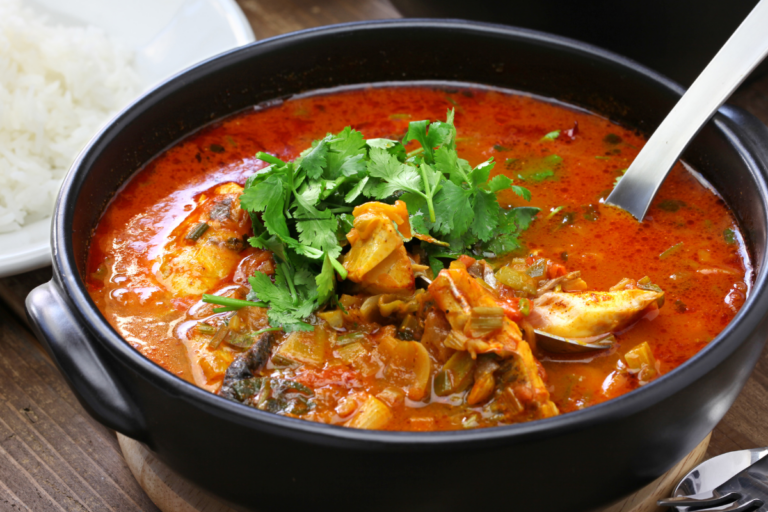Moqueca – When it comes to food, few dishes embody the rich and varied culinary history of the nation quite, like moqueca. This traditional fish stew, with origins dating back more than 300 years, is a blend of indigenous, African, and Portuguese influences. Each bite of moqueca offers a glimpse into Brazil’s mosaic, making it a cherished favorite in many Brazilian homes.
A Comparison of Two Regions: Bahiana and Capixaba Moqueca
Moqueca originates from the areas of Bahia and Espírito Santo, each showcasing its version of the dish.
Bahian Moqueca, also known as Moqueca Baiana showcases the impact on cuisine. This rendition is distinguished using dendê oil (palm oil) and coconut milk. Introduced by slaves, dendê oil gives the stew its bright orange color and a deep earthy taste, while coconut milk contributes a creamy richness. The blend of these elements with seafood, tomatoes, onions, garlic, and cilantro results in a stew that’s both lively and aromatic.
In contrast to this style is Capixaba Moqueca, from Espírito Santo which reflects a heritage. This version does not incorporate dendê oil or coconut milk.
Instead, they use olive oil and annatto seeds (urucum) to add both color and flavor to the dish. The main focus is, on showcasing seafood paired with tomatoes, onions, and bell peppers as well as herbs like cilantro and parsley, reflecting the influence of Portuguese cuisine on the local food scene.
Historical Cultural of Moqueca
The origins of Moqueca are deeply intertwined with the history and cultural development of Brazil. Initially, indigenous people in Brazil created fish stews using ingredients and traditional cooking techniques. When the Portuguese arrived in the century, they introduced elements like olive oil and various herbs. Subsequently, African influences from the slave trade brought ingredients such as dendê oil and coconut milk, enriching the flavors of this dish.
Beyond its appeal, moqueca carries cultural value in Brazil. In Bahia specifically, it is closely linked to Afro traditions like Candomblé. This spiritual practice that blends African beliefs with Catholicism often incorporates moqueca as an offering to deities, underscoring the connection between food and spirituality.
A Dish Celebrating Unity and Togetherness
Moqueca is commonly prepared for events, family gatherings, and communal festivities. The process of making moqueca typically involves an effort, in the kitchen, where family members and friends come together to cook this dish.
In culture, there is an emphasis, on community and unity as showcased by the tradition of sharing a pot of moqueca. This act does not bring people together. It also serves as a way to celebrate heritage and show respect for the past.
Including Moqueca in Your Dining Experience, today, moqueca remains a dish that holds significance both in Brazil and across the globe. Its delicious flavors and cultural importance have earned it acclaim internationally. Chefs worldwide have embraced moqueca often adding their touches to the classic recipe while paying homage, to its roots.
Here’s a simple way to cook Bahiana Moqueca, in your kitchen
Ingredients:
- 2 pounds of white fish (such as sea bass or grouper) cut into pieces
- 1 pound of shrimp, peeled and cleaned
- Juice of 3 limes
- 4 cloves of garlic finely chopped
- Salt and pepper to your liking
- 2 tablespoons of dendê oil (palm oil)
- 1 large onion, thinly sliced
- 1 red bell pepper, thinly sliced
- 1 yellow bell pepper, thinly sliced
- 4 large tomatoes, diced
- 1 can (14 ounces) of coconut milk
- A handful of fresh cilantro leaves chopped
For the Capixaba version: add 1 tablespoon of olive oil and a teaspoon of annatto seeds
Instructions To Prepare:
Marinate the Seafood:
In a bowl mix the fish and shrimp with lime juice, minced garlic, salt, and pepper. Allow it to marinate for around half an hour.
Prepare the Base:
Warm up the dendê oil in a pot on heat. If you’re trying the Capixaba style, replace it with olive oil and include annatto seeds until the oil changes color, to reddish; then take out the seeds.
Add the sliced onions and bell peppers to the pot. Cook them until they become tender, which should take around 5 minutes.
Next, include the tomatoes. Cook until they start to soften and create a sauce, which usually takes about 10 minutes.
Introducing Coconut Milk:
Pour the coconut milk into the pot and mix it well with the tomato mixture. Let it come to a simmer.
Prepare the Seafood:
Place the fish and shrimp into the pot ensuring they are fully immersed in the broth. Cover the pot. Allow it to simmer until the seafood is thoroughly cooked and tender, around 15 to 20 minutes.
Final Touches Before Serving:
Mix in the chopped cilantro. Adjust the seasoning with more salt and pepper if necessary.
Serve this moqueca piping alongside white rice to soak up all those rich flavors in the broth, along with farofa (toasted cassava flour) for an extra delightful crunch.
Moqueca represents more than a meal; it embodies an exploration of Brazil’s intricate history and diverse culture. Whether you prefer Bahian or Capixaba style, moqueca provides a glimpse into Brazil’s cuisine. The next time you’re seeking tastes and cultural experiences, consider adding moqueca to your dining table as a tribute, to Brazil’s vibrant heritage.
What Next:
- Crocodile Ice Cream: A Wild Adventure in Dessert-Making
- Pasta Carbonara- A Classic Italian Delight
- Japanese Miso Glazed Salmon – A Delicious Taste and Health
- Feijoada – A Taste of Brazil
- Bouillabaisse – The Legendary Fish Stew, from Marseille


